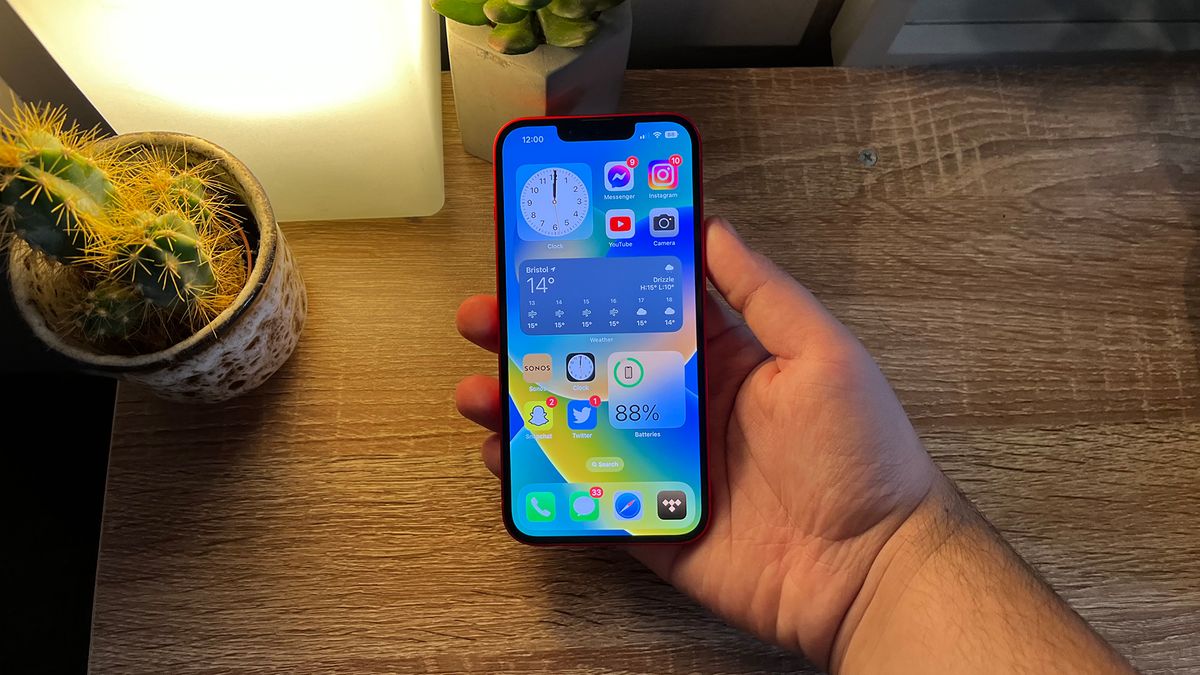What Hi-Fi? Verdict
While it's a shame that picture and sound quality haven't been upgraded, the iPhone 13 was great in these regards and the iPhone 14 is, too
Pros
- +
Excellent display
- +
Admirable headphone performance
- +
Solid build quality
Cons
- -
No upgrades to picture or sound
- -
Familiar design
- -
Notch is still present
Why you can trust What Hi-Fi?
It’s September once again; the summer is drawing to a close, there’s the faintest chill in the air and pumpkin spice lattes are back on the menu. However, there’s one pivotal thing in the world of tech that also happened this September, as it has for many years before it.
Like clockwork, Apple has launched a plethora of new iPhones and, you guessed it, they’re the best iPhones yet. The iPhone 14 comes in practically every shape and size, with the Pro undoubtedly being the more exciting of the bunch with its “Dynamic Island” notch and upgraded internals.
But we’re here to talk about the standard, and cheapest iPhone 14, and while it may be a solid phone, it's also practically identical to its predecessor. Same chassis, same screen, same processor – so is this just an iPhone 13S, or an unenthusiastic placeholder for Apple while it gives the 14 Pro time to live in the limelight?
Price
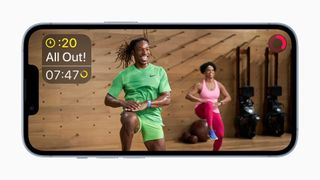
Rumours circulating of a pricier iPhone 14 have unfortunately been proven true for many regions. The iPhone 14 now starts at £849 / $799 / AU$1399 – an increase of £70 and AU$50 over the iPhone 13 in the UK and Australia respectively. The price in the US stays the same, but this international price hike is concerning.
The iPhone 13 is staying in the iPhone range, and Apple has in fact given it a new, lower price of £749 / $699 / $1229. Is the iPhone 14 worth the extra £100 / $100 / AU$170? It rather depends on how important the camera is to you.
Build
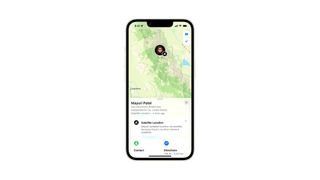
Despite the iPhone 14’s inflated price, it has the same A15 Bionic processor found in the iPhone 13 and the same 128GB base storage configuration. This is backed by an extra 2GB of RAM, which should keep daily use and multitasking running smoothly, and the 14 apparently has more sophisticated cooling to ensure the processor doesn’t overheat – but it is hard to ignore the fact that the guts of the 14 are almost identical to those of the 13.
The similarities between the 14 and 13 don’t end there either. The iPhone 14 is practically identical to its predecessor when it comes to the outer shell too, to the extent that most people would be hard-pressed to differentiate between the two models in a line-up. The same flat aluminium frame sandwiched between two sheets of glass remains, with the same 6.1-inch OLED Super Retina display up front. The 14 does come in some new colours, however, with Midnight (black/navy), Starlight (silver), and Product Red being joined by two soft pastel shades of Blue and Purple.
It features all of Apple’s trademarks for a modern iPhone; mute switch, lightning port and dual camera system, all in their respective usual places. Apple has also retained the shrunken-down notch found on the 13, something that may be controversial as early rumours suggested a redesign; which we now know to be a 14 Pro exclusive.
The construction of the device is sturdy, rigid, and high-quality – we can’t pick any faults there. But if you’re the type of person who wants everyone to know you have the latest and greatest iPhone, you may be disappointed by the 14’s understatement.
Features
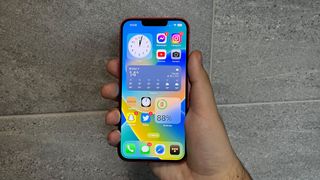
Here is where we begin to see some new aspects of the iPhone 14, although there are plenty of returning features we should probably address first. The stellar Super Retina OLED display of the iPhone 13 makes a return at the same 2532 x 1170 resolution and 1200 nits of brightness. HDR10 and Dolby Vision support return, while HLG is added. The one obvious disappointment is that ProMotion is yet to trickle down to the non-Pro iPhones, so the 14 is stuck at 60Hz. For the price, Apple needs to up its game here – 90 or 120Hz screens are becoming increasingly common in phones half the price of the 14.
Some more Apple-centric features that remain are the Face-ID sensor and Magsafe accessory interface. Face recognition on the iPhone remains leagues ahead of Android competitors, always proving snappy and convenient yet secure and reliable. Magsafe is perhaps less vital, but the magnetic charger snapping into place is always satisfying.
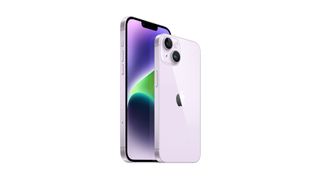
Screen 6.1-inch OLED
Resolution 2532 x 1170
Finishes x5 (Midnight, Starlight, Product Red, Blue, Purple)
OS iOS 16
Battery size 3279mAh
Storage 128GB / 256GB / 512GB
RAM 6GB
The iPhone 14 also comes equipped with Apple’s latest operating system – iOS 16. Most of the updates here are aesthetic, with new customisable lock screens and a shared iCloud photo library. It does bring some new features to the iPhone that are more consequential, though you hopefully won’t have to use them any time soon. The first is car crash detection, which can automatically contact emergency services if the phone detects that you have been in an accident. Second is satellite connectivity, which can be used to make emergency calls if you’re lost or stranded somewhere without a signal – although this is exclusive to the US and Canada at this time.
The real upgrade that differentiates the iPhone 14 from the 13 is the camera system. The front camera now includes digital autofocus for clearer selfies, while the rear cameras are now bigger and faster. Still comprising a pair of 12MP shooters, including a standard wide and ultrawide lens, the main sensor now features bigger pixels and a faster aperture, resulting in improved performance in both daytime shots and Night Mode. In practice, the iPhone provides clear and crisp shots, although that's not surprising as iPhones have topped many smartphone camera rankings for over a decade now.
Battery size has also been increased slightly, from the 13’s 3240mAh to 3279mAh. While this isn’t earth-shattering by any means, the 14 easily makes it through the day without having to resort to battery-saving measures.
Picture
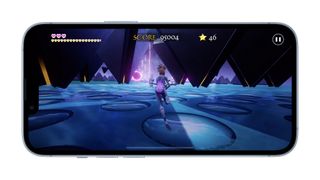
The fact that the iPhone 14 has the exact same screen specifications as last year’s model might lead you to expect some pretty familiar results here, but new iPhones often contain hidden picture-quality upgrades. Unfortunately, that isn't the case here, though that isn't exactly a bad thing, as the iPhone 14 is sharp, well-balanced, bright and a top-notch (pun intended) performer overall.
Firing up the bombastic Thor: Love And Thunder on Disney Plus, the newest iPhone shines with formidable colours that pack a punch where needed, while keeping skin tones incredibly realistic and natural. From the fine details of the intricate designs of aliens to the wisps of Odinson’s golden locks, everything is reproduced in sharp and crisp fashion. Altogether, the iPhone produces a stunning image that effortlessly combines naturalism and punch.
Contrast is a defining feature of the iPhone’s display too, with the extra brightness added with last year’s model continuing to dazzle, yet refusing to sacrifice dark details. The impeccable contrast and sharply defined edges result in a picture that oozes three-dimensional depth. This screen is a true all-rounder – as is the iPhone 13’s.
Sound
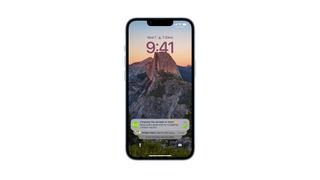
Much as with the picture performance, if there are differences to the iPhone 14’s audio performance then we are hard-pressed to find them. The audio performance of the 14 is strikingly similar to that of the 13. The iPhone still requires a Lightning to 3.5mm audio adapter (not included in the box) since it ditched the headphone socket back with the iPhone 7, but Bluetooth is always an alternative for those wanting a wireless solution.
Using wired headphones is still the way to go if you want the very best audio performance, and physically plugging a pair of headphones into the new iPhone is as rewarding as it's ever been. James Blake’s Limit To Your Love carries weighty bass with sparkling and clear vocals, and each aspect of the track is given space to flex. The piano sounds natural and textured, while the synthesised aspects are controlled and tight. Timing is snappy and the iPhone’s excellent handling of dynamics allows for the dramatic sections of the song to punch through alongside the softer moments. Other than being no better than its predecessor here, it's impossible to pick faults in the iPhone 14’s headphone presentation.
The loudspeakers are also very good by smartphone standards. Vocals are clear and punchy, utilising the stereo set-up to create a more spacious arrangement than you get from the vast majority of phones. Bass could be slightly better as it lacks impact at times, but it still outperforms other phones at this level. Swapping back to the latest Marvel romp, the mix of vocal clarity and spatial separation makes for a more than ample movie-watching experience.
Verdict
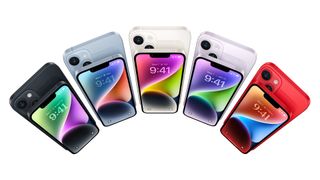
The iPhone 14 is an anomaly in the history of Apple’s smartphones. There have been plenty of instances when the yearly iPhone iteration has been uncannily similar to the previous year’s model, but it's never been this close. And even those previous models that have promised no picture and sound upgrades over their predecessors have often contained surprise, subtle improvements. The iPhone 14 does not follow this path: its AV performance is essentially identical to that of the iPhone 13.
We're not going to be too harsh on the iPhone 14 as it is truly a five-star device; both the picture and audio are thoroughly brilliant, but the fact that the iPhone 13 remains on Apple’s roster makes the 14 a harder sell if media consumption is your main priority.
That said, if you want the awesome picture and sound quality of last year with an even better camera, the iPhone 14 still makes perfect sense.
SCORES
- Build 5
- Picture 5
- Sound 5
MORE:
All the details on the iPhone 15
Read our review of the iPhone 13
These are the best smartphones for music and movies
What Hi-Fi?, founded in 1976, is the world's leading independent guide to buying and owning hi-fi and home entertainment products. Our comprehensive tests help you buy the very best for your money, with our advice sections giving you step-by-step information on how to get even more from your music and movies. Everything is tested by our dedicated team of in-house reviewers in our custom-built test rooms in London, Reading and Bath. Our coveted five-star rating and Awards are recognised all over the world as the ultimate seal of approval, so you can buy with absolute confidence.
-
mccartymind I recently purchased the iPhone 14 standard model. I had an IPhone X before that. After a bit of using my new 14 in the car using a lightening to 3.5mm music has been sounding bright and harsh. I compared it to my X and my ten sounded warmer and notes were richer while the 14 sounded pointy and flat and hurt my ears. So I ordered a 13 and another 14 to compare. Strangely, the new 14 didn’t get near as loud as my first 14. Noticeably. So huge variance between phones. The 13 seemed a bit better in terms of less harsh but also didn’t get as loud turned all the way up. I also compared them all with my wife’s iPhone 12 Pro Max and my daughters iPhone 8, both of which sounded normal to me for what I’m used to hearing in an iPhone. Richer, warmer, easier to listen to even when loud. But both iPhone 14 phones have issues in my mind as well as the 13. Seems super strange to me and greatly disappointing cause I use my phone for music more than anything and I am going to have to buy another X or Xs as I don’t like big phones, so not interested in pro versions. I guess I could try a 12 but I’m gonna be buying phones for awhile. My only hope is that my ears just happen to be sensitive to a new device and the Dac needs to wear in but it hasn’t happened after a week and I doubt the sound is gonna change that much when 3 new phones out of the box sound different from each other and different from previous models. Sound is subjective of course, but something is off. To be clear, the issue is when any headphone or cable is plugged into lightning jack.Reply
